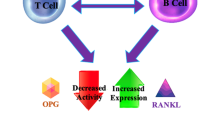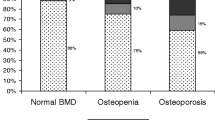Abstract
Recently, osteoporosis has attracted concern among physicians treating patients with human immunodeficiency virus (HIV)/acquired immune deficiency syndrome (AIDS). Many confounding factors are assumed to play a role in its pathogenesis. The discussion has increased dramatically since the introduction of highly active antiretroviral therapy (HAART), and, in fact, the pertinent data have become much more contradictory. In this study, we have evaluated the BMD of our HIV/AIDS patients, comparatively by two methodologies: dual energy X-ray absorptiometry (DXA) and digital X-ray radiogrammetry (DXR). The study comprised 27 HIV/AIDS patients (15 males, 12 females). Bone mineral density measurements using DXA (Hologic QDR-4500) were performed at the lumbar spine (L1–L4), femur and distal radius. DXR evaluations were done by Pronosco X-posure system (Sectra Pronosco, Denmark) using the X-ray graphs of the patients’ non-dominant hands. Nine patients (33.33%) were found to have osteoporosis. Fourteen (51.85%) had osteopenia and four (14.81%) were normal. Estimated BMD and cortical thickness measurements obtained from DXR significantly correlated with lumbar, femoral and radial DXA measurements. Whether disease-related or drug-related, the tendency to a decline in the bone mass of these patients exists, and future studies are awaited to unravel the clinical significance of osteopenia, risk of fracture and the individual differences between HAART regimens in HIV/AIDS. We also believe that launching screening and treatment guidelines for osteoporosis in these patients will then become reasonable. Last but not least, DXR appears to be a promising tool in this regard.
Similar content being viewed by others
References
Salzman NP, Psallidopoulos M, Prewett AB, O’Leary R (1993) Detection of HIV in bone allografts prepared from AIDS autopsy tissue. Clin Orthop 292:384–390
Kong Y-Y, Feige U, Sarosi I, Bolon B, Tafuri A, Morony S, Capparelli C, Li J, Elliott R, McCabe S, Wong T, Campagnuolo G, Moran E, Bogoch ER, Van G, Nguyen LT, Ohashi PS, Lacey DL, Fish E, Boyle WJ, Penninger JM (1999) Activated T cells regulated bone loss and joint destruction in adjuvant arthritis through osteoprotegerin ligand. Nature 402:304–309
Thomas J, Doherty SM (2003) HIV infection—a risk factor for osteoporosis. J Acquir Immune Defic Syndr 33:281–291
Paton NIJ, Macallan DC, Griffin GE, Pazianas M (1997) Bone mineral density in patients with human immunodeficiency virus infection. Calcif Tissue Int 61:30–32
Tebas P, Powderly WG, Claxton S, Marin D, Tantisiriwat W, Teitelbaum SL, Yarasheski KE (2000) Accelerated bone mineral loss in HIV-infected patients receiving potent antiretroviral therapy. AIDS 14:F63–F67
Carr A, Miller J, Eisman JA, Cooper DA (2001) Osteopenia in HIV-infected men: association with asymptomatic lactic acidemia and lower weight pre-antiretroviral therapy. AIDS 15:703–709
Fairfield WP, Finkelstein JS, Klibanski A, Grinspoon SK (2001) Osteopenia in eugonodal men with acquired immune deficiency syndrome wasting syndrome. J Clin Endocrinol Metab 86:2020–2026
Moore AL, Vashisht A, Sabin CA, Mocroft A, Madge S, Phillips AN, Studd JW, Johnson MA (2001) Reduced bone mineral density in HIV-positive individuals. AIDS 15:1731–1733
Nolan D, Upton R, McKinnon E, John M, James I, Adler B, Roff G, Vasikaran S, Mallal S (2001) Stable or increasing bone mineral density in HIV-infected patients treated with nelfinavir or indinavir. AIDS 15:1275–1280
Loiseau-Peres S, Delaunay C, Poupon S, Lespessailles E, Ballouche N, Arsac P, Benhamou CL (2002) Osteopenia in patients infected by the human immunodeficiency virus. A case control study. Joint Bone Spine 69:482–485
Vescini F, Borderi M, Buffa A, Sinicropi G, Tampellini L, Chiodo F, Caudarella R, Campanacci D (2003) Bone mass in HIV-infected patients: focus on the role of therapy and sex. J Acquir Immune Defic Syndr 33:405–412
Aukrust P, Haug CJ, Ueland T, Lien E, Muller F, Espevik T, Bollerslev J, Froland SS (1999) Decreased bone formative and enhanced resorptive markers in human immunodeficiency virus infection: indication of normalization of the bone-remodeling process during highly active antiretroviral therapy. J Clin Endocrinol Metab 84:145–150
Moyle GJ, Newey C, Baldwin C et al (2000) Osteopenia: a consequence of HIV not HAART? Antivir Ther 5:43
Hoy J, Hudson J, Law M et al (2000) Osteopenia in a randomized, multicentre study of protease inhibitor substitution in patients with the lipodystrophy syndrome—extended follow up to 48 weeks. Antivir Ther 5:42
Nolan D, Upton R, James I et al (2000) Longitudinal analysis of bone mineral density (BMD) in HIV-infected patients treated with HAART: changes in BMD correlate with change in subcutaneous fat; with an additional independent effect of indinavir therapy to increase BMD. Antivir Ther 5:20
Guaraldi G, Ventura P, Albuzza M, Orlando G, Bedini A, Amorico G, Esposito R (2001) Pathological fractures in AIDS patients with osteopenia and osteoporosis induced by antiretroviral therapy. AIDS 15:137–141
Stephens EA, Das R, Madge S, Barter J, Johnson MA (1999) Symptomatic osteoporosis in two young HIV-positive African women. AIDS 13:2605–2606
Clay PG, Lam AI (2003) Testosterone replacement therapy for bone loss prevention in HIV-infected males. Ann Pharmacother 37:582–585
Ward KA, Cotton J, Adams JE (2003) A technical and clinical evaluation of digital X-ray radiogrammetry. Osteoporos Int 14:389–395
Bouxsein ML, Palermo L, Yeung C, Black DM (2002) Digital X-ray radiogrammetry predicts hip, wrist and vertebral fracture risk in elderly women: a prospective analysis from the study of osteoporotic fractures. Osteoporos Int 13:358–365
Rosholm A, Hyldstrup L, Backsgaard L, Grunkin M, Thodberg HH (2001) Estimation of bone mineral density by digital X-ray radiogrammetry: theoretical background and clinical testing. Osteoporos Int 12:961–969
Jorgensen JT, Andersen PB, Rosholm A, Bjarnason NH (2000) Digital X-ray radiogrammetry: a new appendicular bone densitometric method with high precision. Clin Physiol 20:330–335
Hyldstrup L, Nielsen SP (2001) Metacarpal index by digital X-ray radiogrammetry: normative reference values and comparison with dual X-ray absorptiometry. J Clin Densitom 4:299–306
Author information
Authors and Affiliations
Corresponding author
Rights and permissions
About this article
Cite this article
Özçakar, L., Guven, G.S., Ünal, S. et al. Osteoporosis In Turkish HIV/AIDS patients: comparative analysis by dual energy X-ray absorptiometry and digital X-ray radiogrammetry. Osteoporos Int 16, 1363–1367 (2005). https://doi.org/10.1007/s00198-005-1847-y
Received:
Accepted:
Published:
Issue Date:
DOI: https://doi.org/10.1007/s00198-005-1847-y




